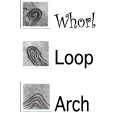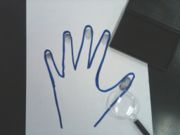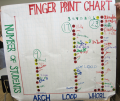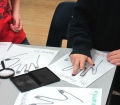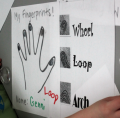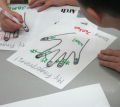Fun with fingerprints
| Students @ Work - a student collaborative writing project. Help us by providing feedback on the Discussion page. |
| Instant wiki maker | Making handouts | Editing tips |
Contents
- 1 Student worthiness
- 2 Primary biological content area covered
- 3 Materials
- 4 Handouts
- 5 Description of activity
- 6 Lesson plan
- 7 Potential pitfalls
- 8 Math connections
- 9 Literature connections
- 10 Connections to educational standards
- 11 Next steps
- 12 Reflections
- 13 Citations and links
- 14 Common mistakes
Biology In Elementary Schools is a Saint Michael's College student project from a course that ran between 2007 and 2010 and fully described in this book chapter. The student-created resources have been preserved here for posterity. Link under 'toolbox' for printer-friendly versions of the exercises. Click on handouts to print full resolution versions. Please see Wikieducator's disclaimer, our safety statement, and the Creative Commons licensing in English and in legalese.
Student worthiness
- This experiment has been tested on 50 second graders and they loved it! It only takes about 20 minutes!
Primary biological content area covered
Students will understand that although we sometimes appear the same on the outside, when we take a closer look we are all very different from one another. This experiment is great to use when discussing the human body in your classroom!
Materials
- Magnifying Glass
- Handouts
- Ink Pad
- Markers
- Large Sheet of Paper (used for graph)
- Soap for clean up!
Handouts
- 1. A piece of paper with an actual hand on it for each student to put his/her fingerprints on. Here is the worksheet that we used!
- 2. A key and description of the different types of fingerprints so that the students can judge eachother's fingerprints and categorize them.
Here is scanned version of the handouts we used for this experiment! Feel free to print them and use them in your classroom!
Description of activity
- Students will learn how there isn't one fingerprint that is exactly the same! Students will be able to fingerprint each of their fingers onto a worksheet using an ink pad. They will then investigate their fingerprints and the fingerprints of their classmates using a magnify-glass. They will decide who has the most "whorly," "archy," and "loopy" fingerprints. This data will then be graphed on a poster sized piece of graph paper so that the entire glasses fingerprints can be shown for all to see!
Lesson plan
Introduction: The teacher(s) will talk to students about how important fingerprints are, and how no ones persons fingerprints are exactly the same! This proves how fingerprints are such an important aspect of each and everyones body! (2-3 min)
Instruction: Teacher(s) will explain to students how to use ink to mark their fingers and place their fingerprints onto the "My Fingerprints!" worksheet. The worksheet should look as follows:
Once the students have completed this worksheet the teacher(s) will go over the different types of fingerprint classifications. The students will then be able to classify not only their fingerprints but also the fingerprints of their classmates (they will only look at each others index fingers for time purposes)! (8-10 min)
Closing: Students will then decide who has the most "whorly," "archy" and "loopy" fingerprints and graph this data (they will stamp their index finger right on the graph for all to see)! Once the lab is over there will be a visual graph of the entire classes fingerprint classifications! (3-5 min)
If there is extra time feel free to allow your students to create some fingerprint art! They will love it!
Potential pitfalls
- Some students may not want to get their fingers dirty.
- Hard-to-read prints
- If students don't want to use ink to print their fingers they can also use the lead from a pencil. To do this heavily color a space on a piece of paper with a Number #2 pencil and then press your finger into this marked space. It will act exactly like ink but washes off much easier!
- Not falling under one specific type (could be a mix of two)
- If the students aren't careful the ink will get all over their clothes and the table.
- Teacher may forget to use a tablecloth so the ink will stain the table in the lab or classroom.
- Teacher may forget to tell his/her students that their fingerprints aren't being taken because they are in trouble (many children associate fingerprints with the police). It is important for the students to know that they are just doing this for fun and they will be keeping their own fingerprints not the teacher or the school.
Math connections
This activity links great to mathematics because the final product is a graph of the classifications of the entire classes fingerprints! This is a great way for the students to realize which fingerprint type is the most popular! A suggestion about the set up of the graph would be to use different colored dot stickers and have the children fingerprint their index finger right onto the sticker. Then they can place it in the correct column and write their name right next to their fingerprint!
Here are some pictures of the graph we used with a total of 49 students:
Literature connections
There are many childrens books that involve fingerprinting! Here are a few that may be useful to have in your classroom when you're implementing this lesson!
Ed Emberley is a famous author for children's fingerprint books! Here are some books that he has written:
- Fingerprint Drawing Book
- This book is a way for kids to make quick and easy fingerprints! There are also many examples of fingerprint art which is fun to recreate!!
- Ed Emberley's Complete Funprint Drawing Book
- This is another great book of fingerprint art! Kids will love to see all of the silly things they can make out of their fingerprints!
- Ed Emberley's Great Thumbprint Drawingbook
- This book is great for thumb print art! Kids love to learn how many faces and animals they can make out of their thumbprint!
If you would like to buy these books for your children at home or in your classroom just simply click on the title of the book! This will link you right to Amazon!
Connections to educational standards
Vermont Department of Education NECAP Science Grade Expectation Grades 1-2
S1-2:40
Students demonstrate their understanding of Human Heredity by…
- Observing and comparing their physical features with those of classmates and other organisms.
Next steps
- After completing this activity, each student will have a set of his or her own fingerprints. Using these fingerprints, the students could form groups and create a short mystery story based around one set of fingerprints which would be the "culprit" fingerprints. The culprit should create another set of fingerprints and the group of students should give the culprit fingerprints, along with all of the other sets of fingerprints from the original activity, to another group. Once the material has been traded, the mystery should be solved by taking a close look at all of the fingerprints compared to the culprit's.
- Another fun activity is using the students fingerprints as a basis for a drawing or little character. This activity would require the children to pick which fingerprints they would like to use and then reproduce those using the ink pad and a whiet piece of paper. Once they have put their prints on the new page, they can decorate them and turn them into a picture with markers, crayons, or colored pencils.
Reflections
After working with the students, we realized that many of them already had a pretty good understanding about fingerprints. Students understood that each person is different, and that no fingerprints are identical. However, many children were unaware of the three main types of fingerprints.
The students loved stamping their fingerprints on their handout sheets and comparing them to their classmates' prints. Even though students already knew about differences in fingerprints, they were unaware of the unique types. This gave the children a sense of individuality because although they may have had the same type of fingerprint as someone else, theirs was still one of a kind.
In our group, we found that there was not enough time for books to be read. Instead of this activity, we showed the children a book about fingerprint art, and they were able to create their own art out of their fingerprints on the handout. Many students got very creative with this exercise.
The students especially enjoyed graphing their fingerprints, and had fun comparing and counting the final numbers to see what type was the most popular.
Also, don't forget to put a table cloth down because the ink is very messy!!!
Here are some awesome pictures from our visit to a 2nd grade classroom!
Citations and links
- Fingerprint Idea from Professor Whiteford's Teaching Math and Science Class
- Fingerprint Art from: National Geographic Kids
- Fingerprint Classification pictures from: Fabulous Forensic Fingerprints
- Ahouse, J.J. and J. Barber. 1987. Fingerprinting Teacher's Guide Grades 4-8. The Regents of the University of California.
Common mistakes
This section is strictly for editorial suggestions and will not be part of your final product. The most common editorial suggestions I make are listed here.
| Work in progress, expect frequent changes. Help and feedback is welcome. See discussion page. |



